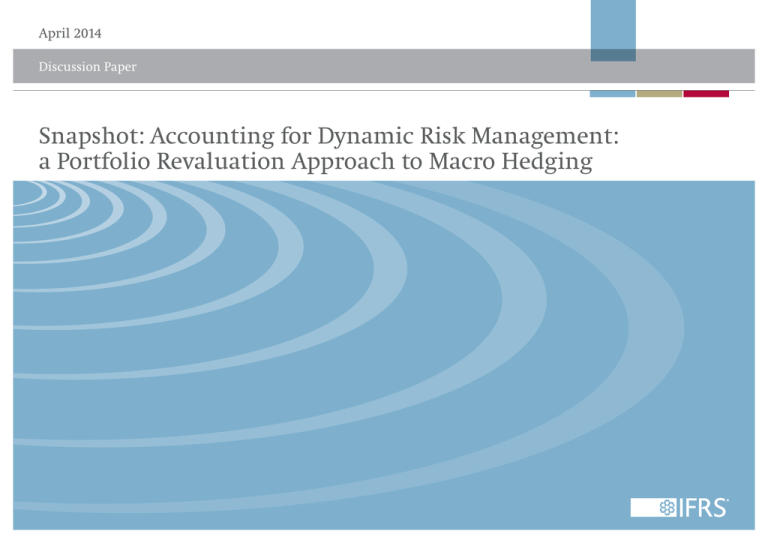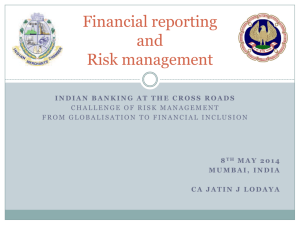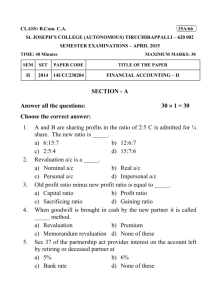
April 2014
Discussion Paper
Snapshot: Accounting for Dynamic Risk Management:
a Portfolio Revaluation Approach to Macro Hedging
At a glance
The IASB explores an accounting
approach to better reflect dynamic
risk management activities in
entities’ financial statements.
Risk management is a common activity that is
applied by many entities. Entities often manage
risk based on open portfolios (ie portfolios that
change over time). Consistent with this, the risk
management process is dynamic, with frequent
monitoring of the net risk positions arising from
open portfolios and corresponding reassessment of
the risk activities.
The Discussion Paper Accounting for Dynamic Risk
Management: a Portfolio Revaluation Approach to Macro
Hedging explores a possible approach to accounting
for an entity’s dynamic risk management activities.
The approach is the portfolio revaluation approach
(PRA). When applying the PRA, exposures within
open portfolios would be revalued with respect to
2 |
the managed risk. This revaluation would offset
the effect of measuring any risk management
instruments (derivative instruments) that are used to
manage those risks at fair value.
The current hedge accounting requirements are
often difficult to apply to dynamic risk management,
because one-to-one designation is usually required
between the hedged item and the hedging
instrument. In addition, there are restrictions
imposed by the current hedge accounting
requirements regarding what can be considered
as eligible hedged items. These constraints make
it difficult to faithfully represent dynamic risk
management in entities’ financial statements and
can increase operational complexity.
The Discussion Paper uses dynamic risk
management of interest rate risk, particularly
as managed by banks, for illustrative purposes.
However, the approach considered in the Discussion
Paper is intended to be applicable to the dynamic
management of risks arising from both financial and
non-financial items.
Discussion Paper 2014 | Accounting for Dynamic Risk Management: a Portfolio Revaluation Approach to Macro Hedging
The International Accounting Standards Board (IASB)
will use the feedback received on the Discussion
Paper to evaluate whether, and how, the new
approach would result in an enhancement of the
usefulness of the information provided by the
financial statements. The feedback will be also
useful to the IASB to assess whether the approach
being explored is operational and to evaluate
whether, and how, it could be applied to other risks.
The comment period of the Discussion Paper ends on
17 October 2014.
Dynamic risk management
Many entities are exposed to
market price movements that
affect their profitability. Managing
these risks on a continuous and
dynamic basis is one of the key
elements of financial risk
management.
For example, for a bank, net interest income is a
significant, often the most significant, contributor
to profitability. However, net interest income is
exposed to changes in interest rates. How well
a bank manages this risk affects its profitability.
Dynamic risk management of interest rate risk is
therefore a critical component of banks’ ongoing
risk management activities.
Dynamic risk management process
tion
a
c
fi
i
ident
mit
igat
ion
sis
analy
Dynamic risk management is a continuous process
that involves identifying, analysing and deciding on
whether, and how, to mitigate a risk(s).
Discussion Paper 2014 | Accounting for Dynamic Risk Management: a Portfolio Revaluation Approach to Macro Hedging
| 3
Dynamic risk management continued...
Dynamic interest rate risk management in banks
In banks, dynamic interest rate risk
management is generally carried out
on a portfolio basis.
Exposures in these portfolios change frequently, as
new exposures are added and existing exposures
mature or are prepaid (open portfolios). This
changing nature of open portfolios requires banks to
continuously reassess their exposure to interest rate
risk in order to manage it.
Dynamic
interest rate
risk
management
on a net basis
New exposures are
frequently added
and exposures
expire
Dynamic risk management is usually performed
on a net basis. This means that an entity assesses
its net risk position(s) arising from open portfolios
in which a specific risk is being managed and
decides whether it mitigates that risk by using
derivatives.
The Discussion Paper sets out a possible approach
for reflecting this dynamic risk management in
the financial statements using interest rate risk
as the basis of the analysis. However, it is not
intended that the approach be limited to interest
rate risk.
4 |
Demand deposits
Mortgages (with
behaviouralisation)
Discussion Paper 2014 | Accounting for Dynamic Risk Management: a Portfolio Revaluation Approach to Macro Hedging
New exposures are
frequently added
and exposures
expire
Time deposits
Corporate loans
No one-to-one
linkage
Core deposits
Risk management
instruments
(for example,
interest rate swaps)
Assets
Liabilities
Risk management instruments
No one-to-one
linkage
The current challenges
The current hedge accounting requirements in IAS 39 Financial Instruments: Recognition and Measurement and IFRS 9 Financial Instruments provide
limited accommodation for some key aspects of dynamic risk management.
Exposures included in
dynamic risk management
Current challenges
Improvement opportunities for a new
accounting approach
One-to-one linkage between what is being hedged
and the hedging derivative does not accommodate
the dynamic nature of risk management.
Enhances the information that entities provide
about their dynamic risk management activities.
Can only accommodate open portfolios by treating
them as a series of closed portfolios with short lives.
Is operationally challenging.
Based more closely on risk management
perspective and systems thereby reducing
operational complexities such as tracking and
amortisations.
Can only indirectly accommodate risk management
on a net basis through gross designation.
Allow for a degree of behaviouralisation of
exposures (for example, prepayable mortgages) but
this is limited.
Limitations make it difficult to align with a risk
management focus or systems.
RECOGNISED ASSETS
AND LIABILITIES
Eligible
hedged
items under
hedge
accounting
Eligible
hedged
items under
hedge
accounting
Items not
eligible for
hedge
accounting
Not measured
at FVTPL
Captures the dynamic nature of risk management
on a net basis better.
Measured
at FVTPL
Considers behavioural factors affecting the risk
arising from the exposures rather than purely
contractual features.
Considers different types of risks managed in open
portfolios.
Items not
eligible for
hedge
accounting
UNRECOGNISED ASSETS AND LIABILITIES
Derivatives
Sources of volatility in profit or loss
FVTPL
Fair value through profit or loss
Discussion Paper 2014 | Accounting for Dynamic Risk Management: a Portfolio Revaluation Approach to Macro Hedging
| 5
The portfolio revaluation approach
The Discussion Paper presents the
PRA as a possible accounting
approach to enhance the
representation of dynamic risk
management in entities’ financial
statements. At the same time the
PRA would enable users of
financial statements to better
understand the performance of an
entity by profit source and
corresponding risk.
would not be included in the PRA. The PRA is
accordingly not a full fair value model.
The revaluation of the managed exposures would
be based on a present value technique. This
revaluation would offset the effect of fair value
changes of the risk management instruments (for
example, interest rate swaps) used to mitigate
those risks.
(Liabilities)
Assets
..........
T+3
When applying the PRA, an entity would identify
the risk being managed that has arisen from
exposures within open portfolios and would
revalue those exposures (managed exposures)
only for changes in the risk being managed
(represented by the green portion of the assets
and liabilities in the following figure). Risks
that are not dynamically managed (for example,
credit margin, represented by the white portion
of the assets and liabilities in the following figure)
6 |
The PRA aims to achieve operational simplicity
(see page 8) and to incorporate behavioural factors
affecting the managed risk (see page 9). However,
the PRA also poses some challenges (see page 10).
Discussion Paper 2014 | Accounting for Dynamic Risk Management: a Portfolio Revaluation Approach to Macro Hedging
T+2
T+1
T=0
Revaluation of
exposures for the
managed risk
(present value)
Fair value of risk
management
instruments
T+1
T+2
T+3 ..........
The portfolio revaluation approach
The revaluation adjustment of the
managed exposures arises from
revaluing the cash flows of those
exposures with respect to the
managed risk. This revaluation
adjustment would be recognised in
profit or loss. The fair value changes
of the risk management instruments
would also be recognised in profit or
loss.
continued...
Revaluation adjustment
Present value of the
exposures for the
managed risk
Net
profit or loss
Fair value of
risk management
instruments
Consequently, the net effect between the revaluation
adjustment of the managed exposures and the fair
value changes of the risk management instruments
is reflected in profit or loss.
Changes in fair value
Discussion Paper 2014 | Accounting for Dynamic Risk Management: a Portfolio Revaluation Approach to Macro Hedging
| 7
Operational simplicity
Some of the operational advantages of applying the PRA would be as follows:
One-to-one matching
not required
Would reduce the complexities associated with one-to-one designations required under current hedge accounting.
Transfer pricing
transactions
The PRA would leverage on transfer pricing mechanisms used by banks internally between asset and liability management
(ALM) and the business units for the purposes of interest rate risk management. The Discussion Paper discusses the use of
the interest rates and the cash flows arising from transfer pricing transactions in the application of the PRA as a proxy.
Presentation of internal
derivatives
ALM typically manages exposures to interest rate risk by transferring risk to a trading unit using internal derivatives.
The PRA discusses the possibility of reflecting the dynamic risk management undertaken by banks using such internal
derivatives by grossing up offsetting internal derivative transactions between ALM and the trading unit in the statement of
comprehensive income, with no net impact on the consolidated profit or loss.
Use of data for risk
management purposes
There is a greater opportunity to use existing dynamic risk management data for accounting purposes.
8 |
Discussion Paper 2014 | Accounting for Dynamic Risk Management: a Portfolio Revaluation Approach to Macro Hedging
Behavioural factors affecting the managed risk
(for example interest rate risk)
Core demand deposits
Even though contractually demand deposits have
a variable interest rate and can be withdrawn at
any time, because of their expected behaviour,
banks consider core demand deposits as a
source of stable fixed interest rate funding. They
accordingly consider them as fixed interest
rate liabilities for the purposes of dynamic risk
management.
Consequently, dynamic risk management of
interest rate risk considers the behavioural
features of those deposits rather than their
contractual features. For dynamic risk
management purposes, the expected cash flow
profiles of the exposures incorporate behavioural
factors that affect the managed risk.
a conceptual challenge because, for accounting
purposes, deposits that are callable on demand are
assumed to have zero fair value risk with regard to
interest rate changes.
Demand deposit portfolio
Amount
outstanding
Prepayment risk
Another example of behaviouralisation can be
seen with portfolios of prepayable instruments.
Banks also typically consider the expected
prepayment behaviour when managing portfolios
of prepayable instruments. The Discussion
Paper considers whether including these
behaviouralised cash flows in the managed
portfolio would be appropriate and whether it
would contribute to a better reflection of dynamic
risk management.
Core demand deposits
The Discussion Paper explores whether the
cash flow of the exposures that are dynamically
managed should be considered on a behavioural
basis. In the case of core demand deposits, the
consideration of behavioural factors represents
Time
Discussion Paper 2014 | Accounting for Dynamic Risk Management: a Portfolio Revaluation Approach to Macro Hedging
| 9
Challenges posed by the PRA
The most significant conceptual challenge when developing the PRA is to determine to what extent dynamic risk
management should be reflected in the accounting. This could also have consequences for operationality and for the
information that would be provided in the financial statements. Some specific challenges are as follows:
Which exposures to include in Determining exposures that would be eligible to be included in the PRA is complex. This is because some exposures that
the PRA
risk managers would include in an open portfolio to achieve a risk management objective are exposures that may not be
recognised for accounting purposes. For example, risk managers may consider exposures that have not yet been contracted
or may target base returns on a bank’s own equity that might not be deemed to be assets or liabilities for accounting
purposes.
Behaviouralisation
Dynamic risk management is usually based on the expected cash flow profile of the exposures while accounting is usually
based on their contractual lives. These different views raise conceptual issues as they lead to different recognition patterns
of gains and losses.
Selection of the funding index The selection of a suitable funding index in the present value computation when determining the revaluation adjustment
might require judgement, because it is not always possible to identify a ‘known’ funding source for particular exposures
representing the managed
that will then provide a basis for determining the transfer price transactions that are to be used when applying the PRA.
risk
Application of the PRA to
other risks
10 |
The Discussion Paper focuses on the application of the PRA in the case of dynamic risk management of interest rate risk.
The application of the PRA to other risks has not been explored with the same level of detail and hence it remains an area
that would need further development. The IASB would like to understand the need for an accounting approach that would
address other dynamically managed risks. Consequently, the IASB is requesting input about the application of the PRA to
other risks (see page 13).
Discussion Paper 2014 | Accounting for Dynamic Risk Management: a Portfolio Revaluation Approach to Macro Hedging
Scope alternatives presented in the Discussion Paper
The Discussion Paper presents two scope alternatives for the application of the PRA (‘a focus on dynamic risk management’ and ‘a focus on risk mitigation’).
A focus on dynamic risk management
In this case, the PRA would capture all the elements
of dynamic risk management activity (ie risk
identification, analysis and mitigation through
hedging). The presence of any one of these elements
would result in an entity applying the PRA to all net
open risk positions regardless of whether they have
been hedged.
Mortgages (with
behaviouralisation)
Corporate loans
Demand deposits
Dynamic
interest rate
risk
management
on a net basis
A focus on risk mitigation
In this case, an entity would apply the PRA only when all three elements of dynamic risk management
have been undertaken (ie assuming risk identification and analysis have been undertaken, this
approach would only apply to those circumstances in which an entity has undertaken risk mitigation
activities through hedging).
Within this alternative, the Discussion Paper presents two additional approaches:
Sub-portfolio approach:
Proportional approach:
the PRA would be limited to only the dynamically
managed sub-portfolios for which risk mitigating
activities through hedging have been undertaken.
hedged positions may be determined as a
proportion of a dynamically managed portfolio.
In that case, the PRA would only be applied to
that proportion.
Core deposits
Time deposits
Corporate loans
Risk management
instruments
(for example, interest
rate swaps)
Demand deposits
Mortgages (with
behaviouralisation)
Dynamic
interest rate
risk
management
on a net basis
Core deposits
Time deposits
Risk management
instruments
(for example, interest
rate swaps)
Demand deposits
Mortgages (with
behaviouralisation)
Corporate loans
Dynamic
interest rate
risk
management
on a net basis
Core deposits
Time deposits
Risk management
instruments
(for example, interest
rate swaps)
Discussion Paper 2014 | Accounting for Dynamic Risk Management: a Portfolio Revaluation Approach to Macro Hedging
| 11
Presentation alternatives of the PRA included in the
Discussion Paper
Statement of financial position
Statement of comprehensive income
The Discussion Paper suggests three alternatives
for the presentation of the revaluation
adjustments arising from the PRA in the
statement of financial position:
The Discussion Paper considers two presentation
alternatives for the statement of comprehensive
income:
Line-by-line gross up—the carrying amount
of exposures included within the managed
portfolio would be adjusted to reflect the
revaluation for the managed risk.
Separate lines for aggregate adjustments
to assets and liabilities—separate line
items would be presented for both the
revaluation adjustments for the exposures
that are assets and those that are
liabilities.
12 |
Actual net interest income presentation—
actual interest revenue and interest
expense are presented along with an
additional interest line item to present net
interest income from risk management
instruments. The revaluation effect from
dynamic risk management activities would
be presented in a separate line item and
would provide information on mismatches
in anticipated future net interest income.
Stable net interest income presentation—
net interest income would be reported
on the assumption that a bank’s risk
management objective is to stabilise net
interest income. The revaluation effect
from dynamic risk management activities
would provide information about how
successfully a bank achieved its objective
for both current and future net interest
income.
Net profit or loss would be the same under both presentation alternatives.
Single net line item—the net revaluation
adjustment for all exposures subject to the
PRA would be presented in a single line
item in the statement of financial position.
Discussion Paper 2014 | Accounting for Dynamic Risk Management: a Portfolio Revaluation Approach to Macro Hedging
Applying the PRA to other risks
Entities in industries such as mining, utility or
manufacturing also undertake dynamic risk
management activities. This is because they
are exposed to commodity price risk or foreign
exchange (FX) risk that could significantly affect
their profitability.
For example, one rationale for an entity to
undertake dynamic risk management would be if
the entity aimed to manage its gross profit from a
particular portfolio of transactions with respect to
commodity price risk. In such a case, commodity
price risk may arise from purchases and sales
(and inventory). In the event that the pricing of
both purchase and sale contracts was based on
the market price of the commodity, dynamic risk
management might focus on identifying pricing
mismatches between purchases and sales (and
inventory), the absence of which could expose the
entity to unstable gross profits.
The IASB is using the Discussion Paper as a basis
for learning more about whether the PRA could
be applied to other risks, such as commodity
price risk or FX risk, and what, if any, special
considerations would be necessary for risks other
than interest rate risk.
Inventory
Sales
Purchases
purchases (fixed or
variable prices)
purchase
commitments (fixed or
variable prices)
forecast purchases
Production
sales (fixed or variable
prices)
sale commitments
(fixed or variable
prices)
forecast sales
Net open risk position
mitigated with
Risk management
instruments
Discussion Paper 2014 | Accounting for Dynamic Risk Management: a Portfolio Revaluation Approach to Macro Hedging
| 13
Seeking your input
Who would be affected by the preliminary
views in the Discussion Paper?
The preliminary views in the Discussion Paper are
potentially relevant to all entities that manage
risks in open portfolios on a dynamic basis. This is
because the intention of the IASB is to understand
whether the development of an accounting
approach for dynamic risk management activities
that would accommodate the management of
different types of risks is necessary.
Nevertheless, the Discussion Paper includes a
comprehensive overview on dynamic interest rate
risk management in the banking sector because
it is a well-known and documented dynamic risk
management activity.
Seeking your input
The development of an accounting approach for
dynamic risk management would not simply be a
modification to hedge accounting requirements.
It would represent a fundamental change in how
risk management is considered for the purposes of
financial reporting.
Given the complexities involved, the publication
of a Discussion Paper provides the IASB with
an appropriate context for seeking feedback on
a broader range of alternatives and for asking
interested parties more varied questions. The
objective of this is to understand whether the
development of an accounting approach that
enhances the usefulness of the information
provided by entities’ financial statements and its
operationality is necessary.
The Accounting for Macro Hedging project
was initially part of IFRS 9 Phase III: Hedge
Accounting. The IASB realised that the
development of a thorough new accounting
approach for dynamic risk management would
take time and this conflicted with the time line
for IFRS 9. Consequently, in May 2012 the IASB
decided to separate the two projects, allowing it
to continue the finalisations of IFRS 9 as planned
while developing an accounting approach for
dynamic risk management as a separate project.
The IASB is particularly interested in understanding whether an accounting approach that reflects how entities manage risks dynamically would help
users of financial statements to understand entities’ dynamic risk management activities.
IASB members and staff will undertake a range of outreach activities internationally during the comment period to discuss the Discussion Paper.
14 |
Discussion Paper 2014 | Accounting for Dynamic Risk Management: a Portfolio Revaluation Approach to Macro Hedging
Further information
The Discussion Paper includes questions on the topics presented in the Discussion
Paper. The IASB’s discussions will take place in public meetings. To access information
about those public meetings, to view the Discussion Paper and to submit your
comments, please visit www.ifrs.org.
The deadline for comments on the Discussion Paper is 17 October 2014.
Next steps
The IASB will consider the comments received on the Discussion Paper and the input
gathered from further outreach to conclude on how to move forward in developing an
accounting approach for dynamic risk management.
Stay informed
To stay up to date with the latest developments and to sign up for email alerts about the
project, please visit the project homepage on http://go.ifrs.org/Dynamic_Risk_Management
Discussion Paper 2014 | Accounting for Dynamic Risk Management: a Portfolio Revaluation Approach to Macro Hedging
| 15
Important information
This Snapshot has been compiled by the staff of the IFRS Foundation as guidance for
interested parties. The views within this document are those of the staff who prepared
this document and are not the views or the opinions of the IASB and should not be
considered authoritative in any way. The content of this Snapshot does not constitute
any form of advice or opinion.
Official pronouncements of the IASB are available in electronic format to eIFRS
subscribers. Publications are available for ordering from our website at www.ifrs.org.
16 |
Discussion Paper 2014 | Accounting for Dynamic Risk Management: a Portfolio Revaluation Approach to Macro Hedging
Notes
Discussion Paper 2014 | Accounting for Dynamic Risk Management: a Portfolio Revaluation Approach to Macro Hedging
| 17
International Accounting Standards Board® (IASB®)
The IASB is the independent standard-setting body of the IFRS Foundation®
30 Cannon Street | London EC4M 6XH | United Kingdom
Telephone: +44 (0)20 7246 6410 | Fax: +44 (0)20 7246 6411
Email: info@ifrs.org | Web: www.ifrs.org
Publications Department
Telephone: +44 (0)20 7332 2730 | Fax: +44 (0)20 7332 2749
Email: publications@ifrs.org
Copyright © 2014 IFRS Foundation®
All rights reserved. No part of this publication may be translated, reprinted, reproduced
or used in any form either in whole or in part or by any electronic, mechanical or other
means, now known or hereafter invented, including photocopying and recording, or in any
information storage and retrieval system, without prior permission in writing from the
IFRS Foundation.
The IFRS Foundation logo/the IASB logo/the IFRS for SMEs logo/‘Hexagon Device’, ‘IFRS
Foundation’, ‘eIFRS’, ‘IASB’, ‘IFRS for SMEs’, ‘IAS’, ‘IASs’, ‘IFRIC’, ‘IFRS’, ‘IFRSs’, ‘SIC’,
‘International Accounting Standards’ and ‘International Financial Reporting Standards’ are
Trade Marks of the IFRS Foundation.
The IFRS Foundation is a not-for-profit corporation under the General Corporation Law of the
State of Delaware, USA and operates in England and Wales as an overseas company (Company
number: FC023235) with its principal office as above.
100%
Printed on 100 per cent recycled paper








